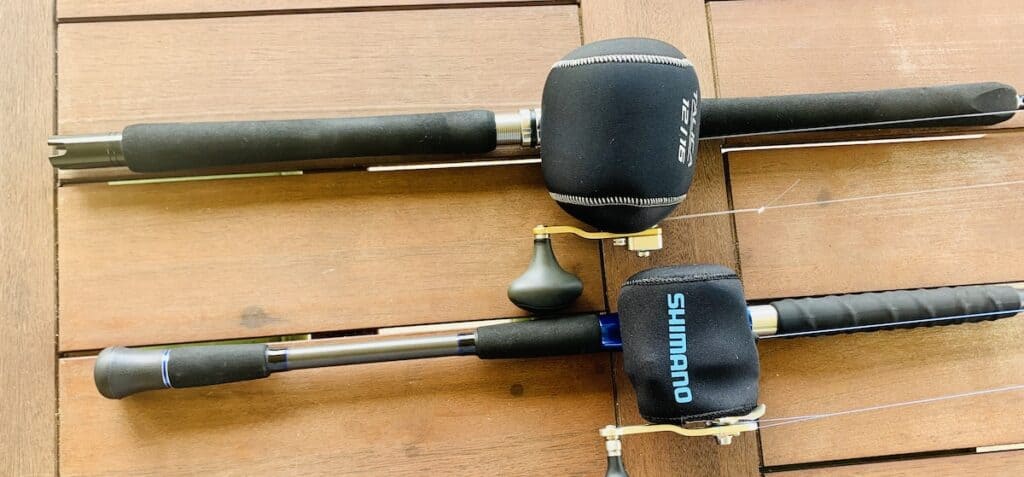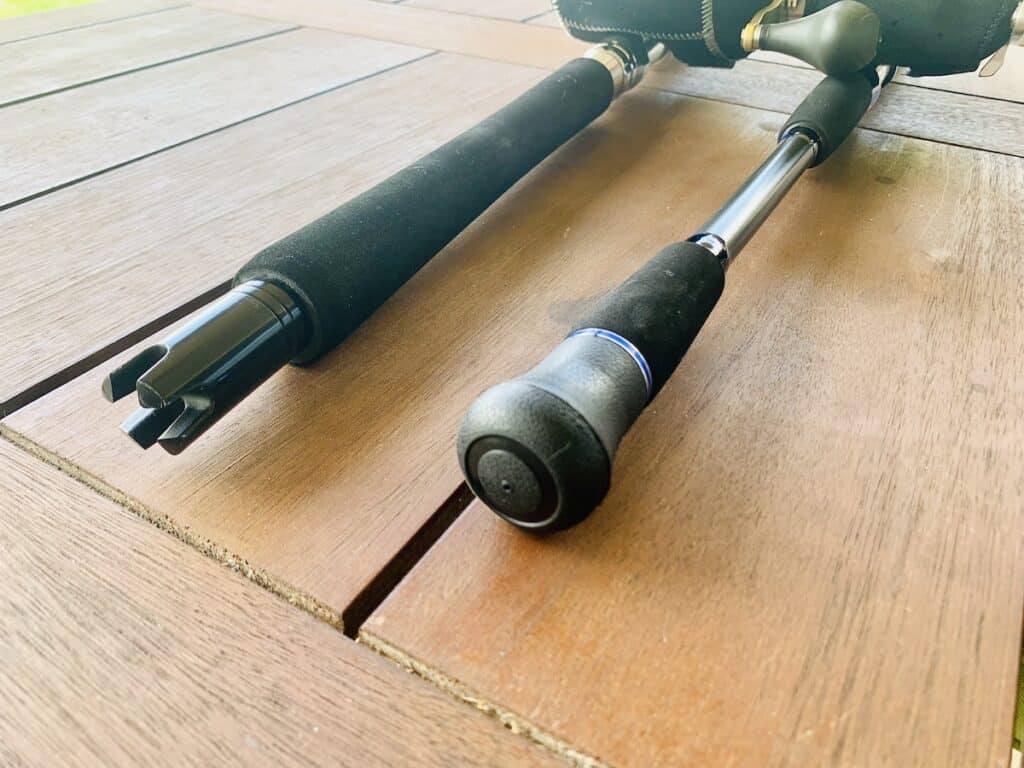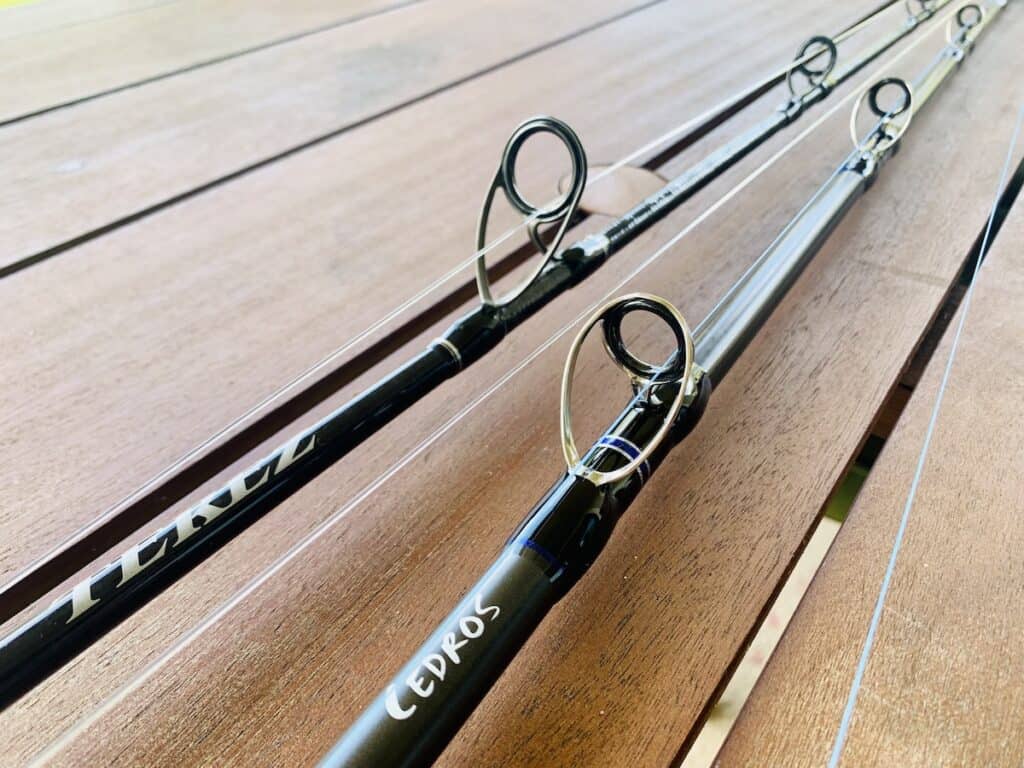Bottom rods can be difficult to find. If you start searching specifically for bottom rods, you’ll likely come up with minimal results. Bottom rods are can be marketed as jigging rods or boat rods. The key to choosing the best bottom rod is knowing what design features you need.
The best mid-price point bottom rod is the Okuma Cedros A conventional rod. The best high-end bottom rod is the Shimano Terez conventional rod. The rod should have heavy power, durable guide inserts to withstand the cutting power of braided main line, and a flexible tip. Keeping reading to learn how the specs of these two rods make them ideal for bottom fishing.
Spinning vs Conventional Rods for Bottom Fishing
When I started looking for bottom rods, I had already decided which reels I would buy. I had my sights set on a Shimano Torium 16PG as my lighter weight reel, and the Shimano Talica 16 2 speed for deeper waters.
Both of these reels are conventional reels, so I needed to look for conventional rods to pair them with. Its normally easy to tell spinning and conventional rods apart in the store by looking at the guides. A spinning rod will have a large diameter guide closest to the reel seat and the diameters will decrease as you look along the rod towards the tip. Spinning rod guides are also on the bottom side of the rod.
A conventional rod may also have different diameter guides, but it’ll be far less dramatic. The guide train on a conventional rod is on the top side of the rod.
Bottom Fishing Rod Length
For bottom fishing, your rod should be somewhere between 6 and 7 feet. Longer rods can become difficult to store on a boat and don’t provide any distinct advantage to bottom fishing. Rods shorter than 6 feet can become difficult when you’re fighting a fish and you need to manuever around the outboard motor.
A rod between 6 and 7 feet in length gives you enough distance away from the boat for the drop, without becoming too difficult to store. Once you narrow down the rod choices to conventional rods between 6 and 7 feet, you’ll need to start looking at power and action.
Bottom Fishing Rod Power and Line Rating
The rod power you need is difficult to determine without also considering your reel size and line strength. I was looking for two bottom rods, to pair with two different reels, so I’ll talk through them independently.
The Okuma Cedros A is a great rod at a mid-price point and I was considering it to pair with my Shimano Torium 16 PG. In the table below, you’ll see the different models available in a 6’6” length. The links in all of the tables and in the article text will take you to product pages at Tackle Direct.
| Rod Model | Power | Length | Line Rating |
| CJ-C-661Ma | M | 6’6” | 30-65 lbs |
| CJ-C-661MHa | MH | 6’6” | 50-100 lbs |
| CJ-C-661Ha | H | 6’6” | 65-150 lbs |
| CJ-C-661XHa | XH | 6’6” | 65-200 lbs |
I knew I would spool my reel with 65 lb line, so it looked like any of the available powers would work. I did want to keep an option to spool my reel with 80 lb line someday if I wanted, so it seemed unlikely that I would end up with the medium power model. I decided to keep an open mind after looking at the power and line rating and see if the action would help me decide on a model.
For the Shimano Talica 16 2 speed reel, I wanted a higher end rod to match. I started looking at the available models of the Shimano Terez conventional rod.
| Rod Model | Power | Length | Line Rating |
| TZC66H | H | 6’6” | 50-150 lb |
| TZCX66H | H | 6’6” | 50-150 lb |
| TZC66XH | XH | 6’6” | 65-200 lb |
| TZCX66XH | XH | 6’6” | 65-200 lb |
I was also planning on spooling the Talica with 65 lb braid, so any of the rod models could potentially work. I prefer my line strength not to be on the boundary of the line rating, though, so I figured I’d probably not choose the Extra Heavy models.
To learn more detail about why I’m choosing to line strength between 65 and 80 lbs, read my article on Bottom Fishing Line.
Bottom Fishing Rod Action
After looking at the different models of the two bottom rods I’m looking at, it’s obvious that the action will be the deciding factor for which rod to get. The rod tip needs to be flexible for bottom fishing because a flexible tip is sensitive enough to feel a gentler bite. A moderate fast, fast, or extra fast action is considered a flexible tip.
Looking at the Okuma Cedros A rod models, it’s now clear which model I should get. The medium heavy power, moderate fast action 6’6” rod has a line rating between 50 and 100 lbs. Since I’ll be using 65 lb braid, I’m comfortable with the line rating. The moderate fast action will have the flexibility I need to sense the bite and it’ll help tire out the fish.
| Rod Model | Action |
| CJ-C-661Ma | M |
| CJ-C-661MHa | MF |
| CJ-C-661Ha | MF/F |
| CJ-C-661XHa | MF/F |
For the Shimano Terez rod, I was leaning towards the heavy power, fast or extra fast action. My 65 lb braid was within the line rating range for both models, so it seemed I could do either one. When I went to my local store and tested the rod, I settled on the fast action. It has a nice amount of bend to it, whereas the extra fast action felt stiffer than I wanted.
Bottom Fishing Rod Grip Style
When bottom fishing, you’ll likely use both a reargrip and a foregrip. The reargrip can be a split grip or a full grip. A split grip is one in which you see a section of EVA next to the reel seat, another section of EVA next to the butt or gimbal, and a section of exposed rod blank in between. This configuration helps lighten the weight of the rod.
A full reargrip is a configuration in which the EVA, or other material, extends from the reel seat completely to the butt or gimbal. This gives the angler the ability to hold the reargrip anywhere along that length.

The Okuma Cedros A rod models all have the same foregrip length of 7.5 inches. This is enough for me to comfortably use the foregrip for my hand position. The rear grip is a nice and long 13.5 inches which gives a good amount of leverage between the angler’s body and the reel seat. The extra heavy action has a full EVA grip and the other models have a split grip. I personally don’t have a strong opinion about split or full grip, so this is ok with me.
| Rod Model | Foregrip Length | Reargrip Length | Rear Grip |
| CJ-C-661Ma | 7.5” | 13.5” | Split EVA |
| CJ-C-661MHa | 7.5” | 13.5” | Split EVA |
| CJ-C-661Ha | 7.5” | 13.5” | Split EVA |
| CJ-C-661XHa | 7.5” | 13.5” | Full EVA |
The Shimano Terez conventional rod is consistent across the models. Each model has a foregrip that’s longer than the Okuma Cedros A, at 11 inches. This is nice for someone with bigger hands. The reargrip is a little shorter than the Okuma at 12.6 inches of full EVA. I like the shorter reargrip length for pairing with the heavier reel because it’ll keep the reel seat closer to my body, putting less stress on my shoulders and arms.
| Rod Model | Foregrip Length | Reargrip Length | Reargrip |
| TZC66H | 11” | 12.6” | Full EVA |
| TZCX66H | 11” | 12.6” | Full EVA |
| TZC66XH | 11” | 12.6” | Full EVA |
| TZCX66XH | 11” | 12.6” | Full EVA |
Bottom Fishing Rod Gimbals
When looking at the gimbals, I had to also consider how I’d be using the setup. I’m planning on using the Okuma Cedros A rod with my Shimano Torium reel in a compact size 16 for smaller fish in shallower water. My wife and I will both be able to hold this lighter setup and bring in lighter weight fish without needed to put the rod in a rod holder.

The rubber butt cap is wider than an aluminum gimbal and will help to spread out the force without needing something else like a fighting belt. For the Okuma rod, it makes sense that I will be ok without an Aluminum gimbal.
| Rod Model | Gimbal |
| CJ-C-661Ma | ALPS non-skid rubber butt cap |
| CJ-C-661MHa | ALPS non-skid rubber butt cap |
| CJ-C-661Ha | ALPS non-skid rubber butt cap |
| CJ-C-661XHa | Machined AL gimbal |
My setup with the Shimano Terez paired with the Shimano Talica size 16 2 speed reel is meant to handle the deeper waters and bigger fish. If my wife ends up using this setup when I’m driving, she’s probably going to need a fighting belt or she’ll need to put it in the rod holder to fight a big fish.
The Aluminum gimbal has notches which will mate with my fighting belt’s crosspins to prevent the rod from twisting back and forth as she reels in. Whenever I use the setup, I’ll likely put a Cush-it over the gimbal and fight the fish standing up. For my larger setup, the Aluminum gimbal is a must have.
| Rod Model | Gimbal |
| TZC66H | AL gimbal |
| TZCX66H | AL gimbal |
| TZC66XH | AL gimbal |
| TZCX66XH | AL gimbal |
Additional details about gimbals and rod butts for bottom rods can be found in my article Bottom Fishing Rod Features.
Bottom Fishing Rod Guides
The Okuma rod has ALPS guides. This will be my first rod with ALPS guides, but I’ve heard good things about them. I know the stainless steel frames will withstand corrosion from the saltwater and the Zirconium inserts will hold up against braid, without breaking the bank.

The Fuji guides on the Shimano Terez are built to withstand the cutting power of braid. They are also designed with corrosion resistance in mind and will last a long time in saltwater conditions. I do recommend always rinsing your guides off with freshwater after a day of fishing to help keep them rust-free.
See the table below for specific guide information about the Okuma Cedros A series rods and the Shimano Terez rods.
| Rod | Guides |
| Okuma Cedros A | ALPS Stainless Steel frames with Zirconium guide inserts |
| Shimano Terez | Fuji BKW frames with Alconite guide inserts |
Blank Construction for Bottom Rods
Since I was looking for one mid-price point and one high end rod, I knew there would be a big difference in the blank construction. The Shimano Terez has Shimano’s Spiral-X and Hi-Power X technology that results in a rod being extremely resistant to twisting which can easily overstress a rod. The fiberglass sheets are wrapped in an alternating pattern to give the rod ultimate torsional strength.
| Rod | Blank Construction Tech |
| Okuma Cedros A | E Glass |
| Shimano Terez | Spiral-X and Hi-Power X |
The Okuma Cedros A rod has Okuma’s E blank construction. It's designed to provide shock absorption when fishing with braid, which is exactly what I plan to do. Using 65 lb test braided main line with a short leader is going to put some stress on the rod during the fight, so I knew I needed something that could hold up against it. Although this rod doesn't have the torsional strength of the Terez, I’m confident it will be enough for the fish we’ll be targeting with the smaller setup.
Conclusion
The Okuma Cedros A and Shimano Terez rods both have the features I was looking for in a bottom rod.
I ended up choosing the 6’6” long medium heavy, moderate fast action Okuma Cedros A rod (model # CJ-C-661MHa) to pair with my Shimano Torium size 16. I plan to use 65 lb braid as my main line and that falls well within the line rating of the rod. I also testing the rod in the store and the tip is a good flexibility for bottom fishing. It is a moderately priced rod, coming in at about $135, so I had to accept that the guides and rod construction are likely lower quality than my higher end rod.
For the Shimano Terez, I purchased the 6’6” heavy power, fast action model. It’s the right length and has great guides and rod construction. I’m happy that I get to experience bottom fishing with a higher end rod and my wife can use it too, thanks to the aluminum gimbal.
I hope this article helps explain why I chose my two bottom rods. To read about why I chose the reels I chose, read my article Why I Bought These Bottom Reels. While you're at it, read my overall guide to bottom fishing here. Tight lines, y’all!

